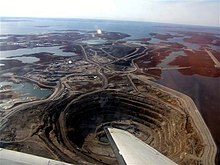Lac de Gras kimberlite field
Appearance


The Lac de Gras kimberlite field is a group of Late Cretaceous to Eocene age diatremes in the Northwest Territories, Canada.[1]
The Eocene (ca. 55-50 Ma) age diatremes of the Lac de Gras kimberlite field support two world-class diamond mines called Ekati and Diavik.[2] Ekati, Canada's first diamond mine,[3] has produced 40,000,000 carats (8,000 kg) of diamonds out of six open pits between 1998 and 2008,[3] while Diavik to the southeast has produced 35,400,000 carats (7,080 kg) of diamonds since its foundation in 2003.[4]
See also
References
- ^ Intensive Variables in Kimberlite Magmas, Lac de Gras, Canada and Implications for Diamond Survival
- ^ North Arrows Minerals Inc.: Lac de Gras Project Archived 2010-06-09 at the Wayback Machine
- ^ a b Zlotnikoc, Dan (November 2008). "A northern star - Canada's first diamond mine celebrates a milestone". CIM Magazine. 3 (7). Montreal, Quebec, Canada: 40–43. ISSN 1718-4177.
- ^ "Diavik diamond mine in N.W.T gets new development money". CBC News. 2007-11-26. Retrieved 2009-01-25.
